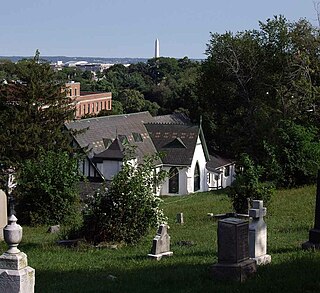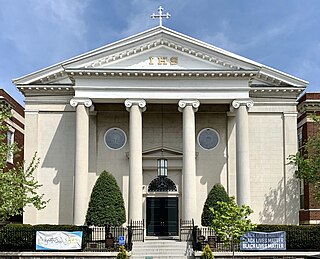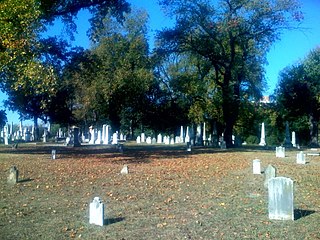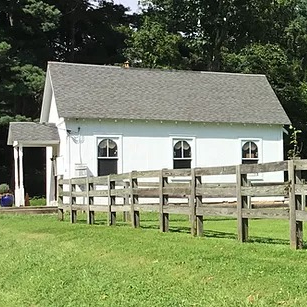
Georgetown is a historic neighborhood and commercial district of Washington, D.C., in Northwest D.C., situated along the Potomac River. Founded in 1751 in the Province of Maryland, the port of Georgetown predated the establishment of the federal district and the City of Washington by 40 years. Incorporated into the District of Columbia, Georgetown remained a separate municipality until 1871 when the United States Congress created a new consolidated government for the whole District. A separate act, passed in 1895, specifically repealed Georgetown's remaining local ordinances and renamed Georgetown's streets to conform with those in the City of Washington.

Mount Olivet Cemetery is a historic rural cemetery located at 1300 Bladensburg Road, NE in Washington, D.C. It is maintained by the Roman Catholic Archdiocese of Washington. The largest Catholic burial ground in the District of Columbia, it was one of the first in the city to be racially integrated.

Holy Rood Cemetery is located at 2126 Wisconsin Avenue N.W. at the southern end of Glover Park, adjacent to Georgetown in Washington, D.C. It is at one of the highest elevations in the city and has memorable views. The cemetery contains approximately 7,000 burials, including as many as 1,000 free and enslaved African Americans. It may be the best-documented slave burial ground in the District of Columbia.

Holy Trinity Catholic Church is a Catholic church run by the Jesuit order that is located in the Georgetown neighborhood of Washington, D.C., in the United States. Holy Trinity Parish was founded in 1787 and is the oldest Roman Catholic community and house of worship in continuous operation both in Georgetown and in the larger city of Washington, D.C. The original church building was completed in 1794. It is now called the Chapel of St. Ignatius, and is used for smaller ecclesiastical celebrations and as an auxiliary space for parish activities. A larger church building, necessitated by the growing community, was dedicated in 1851, and still serves as the parish church today.

The Shockoe Hill Cemetery is a historic cemetery located on Shockoe Hill in Richmond, Virginia.

St. Mark's Cemetery is a historic cemetery located on E. Main Street on the corner of St. Mark's Place in Mount Kisco, Westchester County, New York. The earliest section was established in 1761, and the earliest gravestone to 1773. The last burial was in 1940. Established in 1761, St. Mark's Cemetery served as a burial place for the residents of what was formerly called North Castle and New Castle Corners. The eastern portion of the cemetery was the site of two different churches: St. George's, an Anglican church, from 1761 to 1818, and St. Mark's, an Episcopal church, from 1851 to 1916. The congregations of these two churches used the space around the houses of worship as a burial ground. Additionally, the New Castle Methodist Church, the forerunner of the present United Methodist Church of Mount Kisco, established its own burial ground on the west side of St. Mark's Church in 1854. Both St. Mark's Episcopal Church and United Methodist Church of Mount Kisco deeded their burial grounds to the Village of Mount Kisco in the 1970s, and today the two burial grounds are jointly referred to as St. Mark's Cemetery.

Mount Zion African Methodist Episcopal Church and Mount Zion Cemetery is a historic church and cemetery located at 172 Garwin Road in Woolwich Township, New Jersey, United States. The church was a stop on the Greenwich Line of the Underground Railroad through South Jersey operated by Harriet Tubman for 10 years. The church provided supplies and shelter to runaway slaves on their way to Canada from the South. The church and cemetery were part of the early 19th-century free negro settlement sponsored by Quakers known as Small Gloucester.

The Mount Tabor Methodist Episcopal Church is a historic church building located along State Route 245 near West Liberty in Salem Township, Champaign County, Ohio, United States. Built in 1881 in the Gothic Revival style of architecture, it served a congregation formed in the 1810s. This congregation of the Methodist Episcopal Church worshipped in at least three different buildings before its closure.

Mount Zion United Methodist Church is a historic black church located at 1334 29th Street NW in the Georgetown neighborhood of Washington, D.C., United States.
Columbian Harmony Cemetery was an African-American cemetery that formerly existed at 9th Street NE and Rhode Island Avenue NE in Washington, D.C., in the United States. Constructed in 1859, it was the successor to the smaller Harmoneon Cemetery in downtown Washington. All graves in the cemetery were moved to National Harmony Memorial Park in Landover, Maryland, in 1959. The cemetery site was sold to developers, and a portion used for the Rhode Island Avenue – Brentwood Washington Metro station.

The Presbyterian Burying Ground, also known as the Old Presbyterian Burying Ground, was a historic cemetery which existed between 1802 and 1909 in the Georgetown neighborhood of Washington, D.C., in the United States. It was one of the most prominent cemeteries in the city until the 1860s. Burials there tapered significantly after Oak Hill Cemetery was founded nearby in 1848. The Presbyterian Burying Ground closed to new burials in 1887, and about 500 to 700 bodies were disinterred after 1891 when an attempt was made to demolish the cemetery and use the land for housing. The remaining graves fell into extensive disrepair. After a decade of effort, the District of Columbia purchased the cemetery in 1909 and built Volta Park there, leaving nearly 2,000 bodies buried at the site. Occasional human remains and tombstones have been discovered at the park since its construction. A number of figures important in the early history of Georgetown and Washington, D.C., military figures, politicians, merchants, and others were buried at Presbyterian Burying Ground.
Holmead's Burying Ground, also known as Holmead's Cemetery and the Western Burial Ground, was a historic 2.94-acre (11,900 m2) cemetery located in the Dupont Circle neighborhood of Washington, D.C., in the United States. It was founded by Anthony Holmead in 1794 as a privately owned secular cemetery open to the public. The city of Washington, D.C., constructed the Western Burial Ground on the remainder of the city block in 1798, and the two burial grounds became synonymous. The city took ownership of the private Holmead cemetery in 1820. The unified cemetery went into steep decline around 1850, and it was closed on March 6, 1874. Removal of remains, most of which were reinterred at Graceland Cemetery or Rock Creek Cemetery, continued until 1885.

The A.M.E. Zion Church of Kingston is an African Methodist Episcopal Zion Church located in Kingston, New York. Founded in 1848, as a land grant from wealthy Black residents, Mrs. Sarah-Ann Hasbrouck and her husband, Alexander, it is the oldest continuous African-American congregation in Kingston and Ulster County. The church is located at 26 Franklin Street in the city's Fourth Ward.

Mount Zion Cemetery is a historic African-American cemetery owned by the A.M.E. Zion Church of Kingston. The cemetery is on a 2.4-acre (0.97 ha) lot located at 190 South Wall Street in the city of Kingston. It is in the city's Fifth Ward, less than a mile south of the church.

The Stoutsburg Sourland African American Museum (SSAAM) is a history museum located in the Skillman section of Montgomery Township, New Jersey, United States. The museum is located at the Mount Zion African Methodist Episcopal Church, an African Methodist Episcopal church constructed in 1899. The church was added to the National Register of Historic Places on June 7, 2021.
Alexander Memorial Baptist Church is a Baptist congregation located at 10675 Crain Highway in Upper Marlboro, Maryland, US. The congregation was founded in 1908 after a group of members left First Baptist Church in the Georgetown neighborhood of Washington, D.C. It was named in honor of the founder of First Baptist Church, Reverend Sandy Alexander, who was a formerly enslaved person. For over 100 years, the congregation met in a building located on N Street NW in an area of Georgetown called Herring Hill, which was a 15-block enclave for around 1,000 African Americans families. Alexander Memorial Baptist Church was one of five black churches established in the area.














